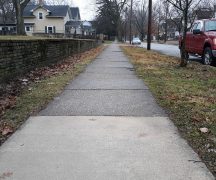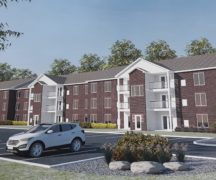By JAN LARSON McLAUGHLIN
BG Independent News
Future sidewalks installed in Bowling Green may allow for wider loads.
The Bowling Green Planning Commission voted unanimously Wednesday evening to change city standards for sidewalks – making them easier for people to use if they are walking side by side, or if they come across someone from the other direction.
City Council will make the final decision on the sidewalk widths.
Public Works Director Brian Craft had suggested that the city change its required sidewalk widths from 4 to 5 feet. The extra foot would be taken from the city right-of-way.
The new wider sidewalks would become part of the city’s subdivision regulations, and would be required for all new sidewalks, said City Planning Director Heather Sayler.
Sidewalks already in place will not be replaced with wider walkways unless large portions of a sidewalk are being redone, Craft said.
During the public hearing Wednesday evening on the sidewalk ordinance change, only one city resident spoke – and he was against the widening.
“I and my neighbors are against wider sidewalks,” said Ken Gutbrod, of Flanders Avenue. “When I look up and down the street, nobody is walking up and down the street.”
In the neighborhood by Stone Ridge Golf Course, the residents all work to afford those homes – so they have no time to take a stroll on sidewalks, Gutbrod said.
Not only are sidewalks not used, but wider walkways will cost more to maintain, he said.
“When you widen a sidewalk, it devalues the house. People prefer to look at the green, not the concrete,” he said.
Gutbrod also suggested that the city set priorities. And spending on sidewalks will hurt the school district – which ought to be a priority.
Planning Commission President Jeff Betts explained to Gutbrod that there are no plans to retroactively widen sidewalks.
“There’s no money for that,” Betts said. “I don’t think you need to be concerned that somebody’s going to force the people on Flanders Avenue to widen their sidewalks. I don’t think you should be concerned that your neighborhood is going to change.”
Betts said that younger people are interested in wider sidewalks, and standards in the region reflect that change.
“It seems pretty clear with all the information we’ve been given, this is something we need to do for Bowling Green – to better the community,” Betts said.
Betts also explained that the money for schools comes from a different fund than the money for sidewalks.
“But all are paid out of the same pot,” Gutbrod said, patting his back pants pocket.
The city has already been installing the wider sidewalks on major corridors for the past two decades. Sidewalks on streets such as East and West Wooster, North and South Main, and East and West Poe are already five-foot wide for “improved efficiency and safety pedestrian movement.”
Just this week, a portion of sidewalk in the downtown area along South Church Street was expanded to five feet.
Other recent improvements of widening sidewalks have been made on Conneaut and Fairview near City Park, and along routes to the middle school and high school.
The city installed at least a five-foot wide walk in these areas, since it is recognized that a four-foot sidewalk is too narrow when pedestrians going in the opposite direction meet, Craft stated.
This is especially true when a pedestrian is using a wheelchair or other assisted mobility device, he pointed out.
This push for wider sidewalks is also being made by the Toledo Metropolitan Area Council of Governments. The theory of the “complete streets” proposals is that wider sidewalks are one element to providing safe and efficient connections between destinations.
The philosophy also is that walking can be a social activity, and facilities are needed to accommodate that activity.
“Anyone who regularly uses sidewalks knows that four-foot wide sidewalks are tight when in use by others,” Craft wrote in his recommendation.
“In the opinion of the BG Engineering Department, it is no longer a satisfactory width to meet the demands of the public,” he said.
Also at Wednesday’s meeting, the planning commission approved the replatting of 2.26 acres in the Bellard Business Park, located in the southeast corner of Brim and Bishop roads. The purpose for the plat change is to allow for more small lots along Bishop Road.
Sue Clark, executive director of the Bowling Green Economic Development Foundation, said the city is almost out of available acreage for small businesses.
“I get inquiries almost every week. They are looking for one or two acres,” Clark said.
Bellard Business Park was intended for contractors and smaller companies. “It was designed for those kind of people in mind,” she said.
In other business, the planning commission set a public hearing for its May 1 meeting on a rezoning request from David Maurer, who is asking that 0.11 acres at 525 Ridge St. be changed from B-1 limited commercial to R-5 university related residential zoning.
Also at the meeting, Sayler reported that the city’s planning department had put out a request for a contractor to update the city’s zoning code and subdivision regulations





